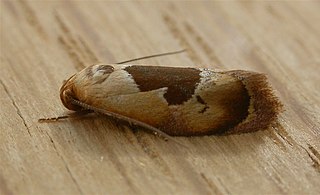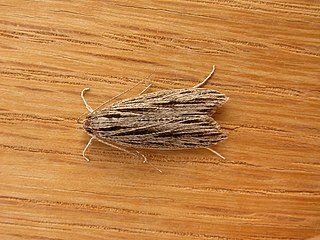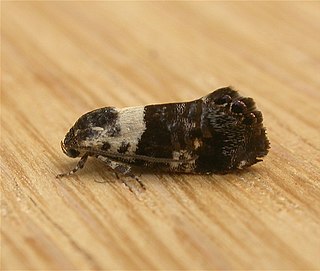
Hoplomorpha camelaea is a moth in the family Oecophoridae first described by Edward Meyrick in 1888. It is found in Australia, where it has been recorded from Victoria, Queensland, New South Wales and the Australian Capital Territory.

Leistarcha scitissimella is a moth of the family Xyloryctidae. It is found in Australia, where it has been recorded from the Australian Capital Territory, New South Wales and Queensland.

Plectophila discalis is a moth of the family Xyloryctidae first described by Francis Walker in 1865. It is found in Australia, where it has been recorded from New South Wales, Queensland and Victoria.

Eupselia aristonica is a species of moth of the family Depressariidae. It is found in Australia, where it has been recorded from New South Wales, the Australian Capital Territory, Victoria and Tasmania.

Lichenaula lichenea is a species of moth of the family Xyloryctidae. It is known in Australia from the Australian Capital Territory, New South Wales and Queensland.
Catacometes hemiscia is a moth in the family Oecophoridae. It was described by Edward Meyrick in 1883. It is found in Australia, where it has been recorded from New South Wales.
Hapalonoma argyracta is a moth in the family Gelechiidae. It was described by Edward Meyrick in 1914. It is found in Guyana.
Hierangela erythrogramma is a moth in the family Gelechiidae. It is found in Burma.
Compsolechia loxogramma is a moth of the family Gelechiidae. It was described by Edward Meyrick in 1922. It is found in Amazonas, Brazil.
Stenoma nebrita is a moth of the family Depressariidae. It is found in Panama, Costa Rica and Guyana.
Zaphanaula hemileuca is a moth in the family Xyloryctidae, and the only species in the genus Zaphanaula. It was described by Turner in 1896. It is found in Australia, where it has been recorded from Queensland.
Clerarcha dryinopa is a moth in the family Xyloryctidae. It was described by Edward Meyrick in 1890. It is found in Australia, where it has been recorded from the Australian Capital Territory, New South Wales and Victoria.
Cryptophasa tetrazona is a moth in the family Xyloryctidae. It was described by Oswald Bertram Lower in 1901. It is found in Australia, where it has been recorded from New South Wales, Queensland, Victoria and Western Australia.
Lichenaula choriodes is a moth in the family Xyloryctidae. It was described by Edward Meyrick in 1890. It is found in Australia, where it has been recorded from New South Wales and Queensland.
Eclecta is a monotypic moth genus in the family Depressariidae. Its only species, Eclecta aurorella, has been found in the Australian state of New South Wales. Both the genus and species were first described by Edward Meyrick in 1883.
Thudaca calliphrontis is a moth in the family Depressariidae. It was described by Edward Meyrick in 1893. It is found in Australia, where it has been recorded from South Australia.
Thudaca campylota is a moth in the family Depressariidae. It was described by Edward Meyrick in 1893. It is found in Australia, where it has been recorded from Western Australia.

Thudaca haplonota is a moth in the family Depressariidae. It was described by Edward Meyrick in 1893. It is found in Australia, where it has been recorded from Western Australia.
Thudaca ophiosema is a moth in the family Depressariidae. It was described by Edward Meyrick in 1893. It is found in Australia, where it has been recorded from Western Australia.
Thudaca orthodroma is a moth in the family Depressariidae. It was described by Edward Meyrick in 1893. It is found in Australia, where it has been recorded from Western Australia.






